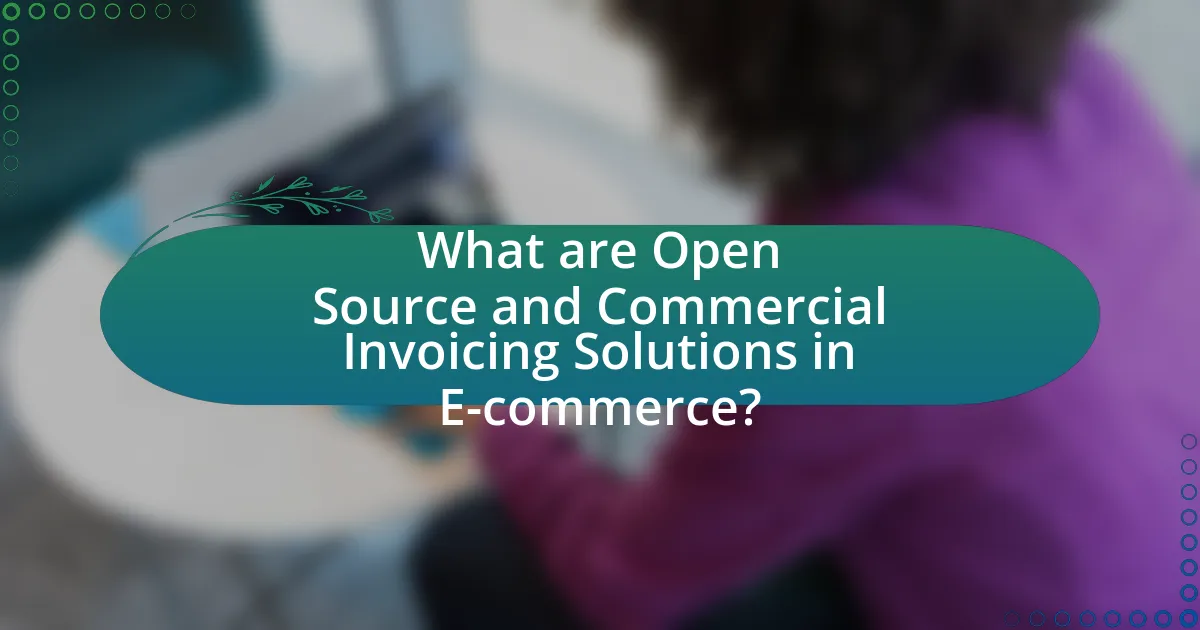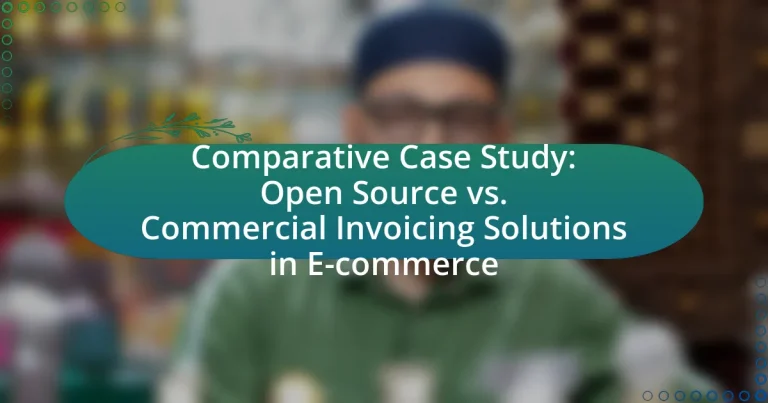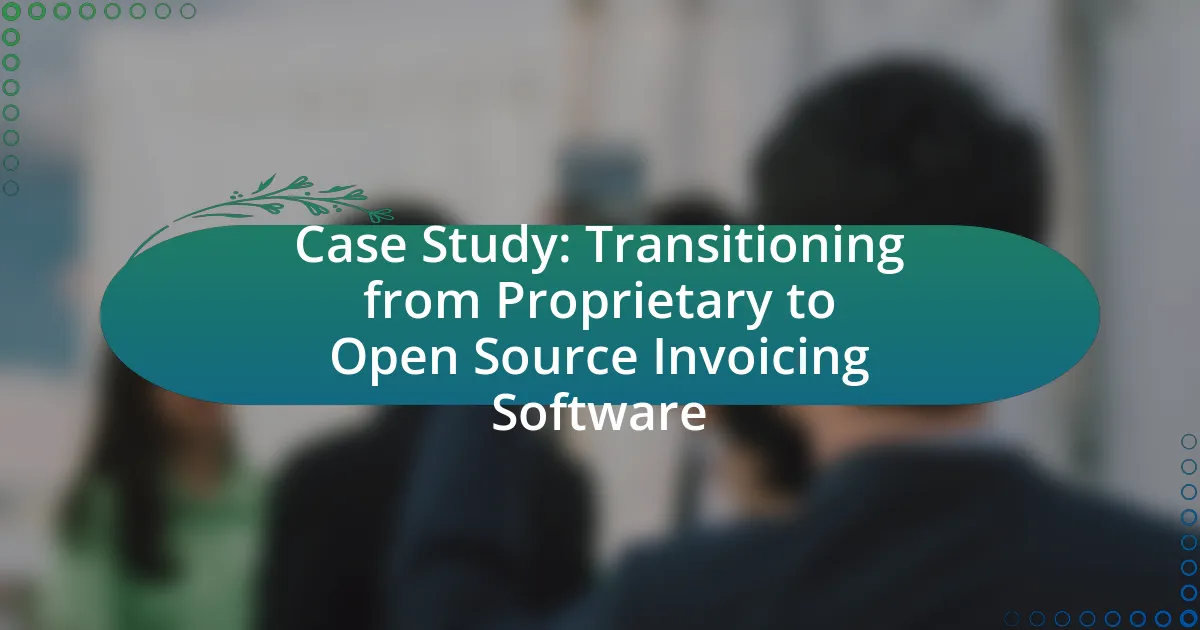The article provides a comparative analysis of open source and commercial invoicing solutions in the e-commerce sector. It outlines the functionalities, advantages, and limitations of both types of software, emphasizing key features such as customization, support, cost-effectiveness, and security. The discussion includes how open source solutions allow for greater flexibility and community-driven improvements, while commercial solutions offer dedicated support and advanced features tailored to business needs. Additionally, the article highlights factors influencing the choice between these solutions, including user requirements, budget constraints, and technical expertise, ultimately guiding businesses in selecting the most suitable invoicing system for their operations.

What are Open Source and Commercial Invoicing Solutions in E-commerce?
Open source invoicing solutions in e-commerce are software programs that allow users to access, modify, and distribute the source code freely, enabling customization and community-driven improvements. Examples include platforms like Invoice Ninja and Dolibarr, which provide flexibility and cost savings for businesses. In contrast, commercial invoicing solutions are proprietary software that requires a purchase or subscription, offering dedicated support and often more polished user interfaces, such as QuickBooks and FreshBooks. These solutions typically come with features tailored for business needs, including advanced reporting and integrations. The choice between open source and commercial solutions often depends on a business’s specific requirements, budget, and technical expertise.
How do Open Source Invoicing Solutions function?
Open source invoicing solutions function by providing users with access to the source code, allowing them to customize and modify the software according to their specific needs. These solutions typically operate on a community-driven model, where developers contribute to the software’s improvement and maintenance. Users can download, install, and run the software on their own servers, which offers greater control over data and functionality compared to proprietary systems. Additionally, open source invoicing solutions often include features such as invoice generation, payment tracking, and reporting, which can be tailored through plugins or extensions. The collaborative nature of open source projects fosters innovation and rapid updates, as seen in platforms like Invoice Ninja and Dolibarr, which have gained popularity for their flexibility and cost-effectiveness in e-commerce environments.
What are the key features of Open Source Invoicing Solutions?
Open Source Invoicing Solutions typically feature customization, flexibility, cost-effectiveness, and community support. Customization allows users to modify the software to meet specific business needs, while flexibility enables integration with various systems and workflows. Cost-effectiveness is a significant advantage, as these solutions often have no licensing fees, reducing overall expenses. Community support provides access to a wealth of resources, including forums and documentation, which can enhance user experience and troubleshooting. These features collectively make Open Source Invoicing Solutions a viable option for businesses seeking tailored invoicing systems.
How do Open Source solutions ensure customization and flexibility?
Open Source solutions ensure customization and flexibility by providing access to their source code, allowing users to modify and adapt the software to meet specific needs. This capability enables businesses to tailor functionalities, integrate with other systems, and implement unique features that align with their operational requirements. For instance, according to a 2021 study by the Open Source Initiative, 78% of organizations using Open Source software reported significant improvements in their ability to customize applications compared to proprietary solutions. This adaptability is further enhanced by the active community support that often accompanies Open Source projects, facilitating ongoing development and innovation.
What are Commercial Invoicing Solutions?
Commercial invoicing solutions are software applications designed to automate and manage the invoicing process for businesses. These solutions streamline the creation, distribution, and tracking of invoices, ensuring accuracy and compliance with financial regulations. According to a report by MarketsandMarkets, the global invoicing software market is projected to grow from $3.5 billion in 2020 to $7.8 billion by 2025, indicating a significant demand for efficient invoicing solutions.
What features distinguish Commercial Invoicing Solutions from Open Source?
Commercial invoicing solutions are typically distinguished from open-source options by their comprehensive support, advanced features, and regulatory compliance. Commercial solutions often provide dedicated customer support, ensuring users receive timely assistance, while open-source solutions may rely on community support, which can be inconsistent. Additionally, commercial invoicing solutions frequently include advanced functionalities such as automated tax calculations, integration with payment gateways, and enhanced security measures, which may not be as robust in open-source alternatives. Furthermore, commercial solutions are designed to comply with various regulatory standards, such as GDPR or PCI DSS, providing businesses with peace of mind regarding legal compliance, whereas open-source solutions may require additional customization to meet these standards.
How do Commercial solutions provide support and maintenance?
Commercial solutions provide support and maintenance through dedicated customer service teams, regular software updates, and comprehensive documentation. These solutions typically include access to technical support via phone, email, or chat, ensuring that users can resolve issues promptly. Regular updates enhance security and functionality, while detailed documentation aids users in navigating the software effectively. For instance, companies like Adobe and Microsoft offer extensive support resources, including forums and knowledge bases, which facilitate user assistance and troubleshooting.
Why is it important to compare Open Source and Commercial Invoicing Solutions?
It is important to compare Open Source and Commercial Invoicing Solutions because each offers distinct advantages and limitations that can significantly impact business operations. Open Source solutions typically provide greater flexibility and customization options, allowing businesses to tailor the software to their specific needs without incurring licensing fees. In contrast, Commercial solutions often come with robust support, regular updates, and integrated features that can enhance user experience and compliance with industry standards. A study by the Software Engineering Institute found that 70% of businesses that evaluated both types of solutions reported improved decision-making and cost-effectiveness by understanding the trade-offs involved. Therefore, a thorough comparison enables businesses to choose the most suitable invoicing solution based on their unique requirements and budget constraints.
What factors should be considered in the comparison?
The factors that should be considered in the comparison of open source versus commercial invoicing solutions in e-commerce include cost, customization, support, scalability, security, and user experience. Cost analysis reveals that open source solutions often have lower initial expenses but may incur higher long-term maintenance costs, while commercial solutions typically involve upfront licensing fees. Customization capabilities differ significantly; open source solutions allow for extensive modifications, whereas commercial options may offer limited flexibility. Support is another critical factor, as commercial solutions usually provide dedicated customer service, while open source relies on community support. Scalability is essential for growing businesses, with commercial solutions often designed to handle larger volumes more efficiently. Security measures vary, with commercial solutions generally offering more robust security features due to regulatory compliance. Finally, user experience can differ, as commercial solutions often prioritize user-friendly interfaces, while open source options may require more technical expertise to navigate effectively.
How do user needs influence the choice between Open Source and Commercial solutions?
User needs significantly influence the choice between Open Source and Commercial solutions by determining factors such as customization, support, and cost. For instance, businesses requiring high customization often prefer Open Source solutions, as they allow for tailored modifications to meet specific operational requirements. Conversely, organizations prioritizing reliable support and maintenance may opt for Commercial solutions, which typically offer dedicated customer service and regular updates. According to a survey by the Open Source Initiative, 70% of users cited flexibility and control as primary reasons for choosing Open Source, while 65% of Commercial solution users highlighted the importance of vendor support. Thus, user needs directly shape the decision-making process between these two types of solutions.

What are the advantages of Open Source Invoicing Solutions?
Open Source Invoicing Solutions offer several advantages, including cost-effectiveness, customization, and community support. These solutions are typically free to use, which significantly reduces overhead costs for businesses compared to commercial alternatives that often require licensing fees. Additionally, open source software allows users to modify the code to fit their specific invoicing needs, enabling tailored functionalities that can enhance operational efficiency. Furthermore, a robust community of developers and users contributes to continuous improvements and troubleshooting, ensuring that the software remains up-to-date and secure. This collaborative environment fosters innovation and provides access to a wealth of shared knowledge and resources.
How do cost savings manifest in Open Source solutions?
Cost savings in Open Source solutions manifest primarily through the elimination of licensing fees associated with proprietary software. Organizations utilizing Open Source software can avoid significant upfront costs, as many Open Source projects are available for free. For instance, a study by the European Commission found that adopting Open Source software can reduce total cost of ownership by up to 30% compared to commercial alternatives. Additionally, Open Source solutions often allow for customization without incurring additional costs, enabling businesses to tailor the software to their specific needs without relying on expensive vendor services. This flexibility further contributes to long-term savings by reducing dependency on external support and fostering in-house expertise.
What are the long-term financial benefits of using Open Source?
The long-term financial benefits of using Open Source include reduced software licensing costs, increased flexibility, and lower total cost of ownership. Organizations can save significantly on licensing fees, as Open Source software typically does not require expensive licenses, allowing for budget reallocation towards other critical areas. Additionally, the flexibility of Open Source allows businesses to customize solutions to fit their specific needs without incurring high development costs associated with proprietary software. According to a study by the European Commission, organizations using Open Source reported a 30% reduction in IT costs over five years compared to those using proprietary solutions. This demonstrates that Open Source not only minimizes upfront expenses but also contributes to sustained financial savings over time.
How does community support enhance Open Source solutions?
Community support enhances Open Source solutions by providing collaborative development, rapid problem-solving, and diverse input, which collectively improve software quality and functionality. For instance, platforms like GitHub enable users to contribute code, report bugs, and suggest features, leading to faster iterations and more robust applications. Research indicates that projects with active community involvement often experience higher user satisfaction and lower defect rates, as seen in the success of projects like Linux and Apache, which thrive on community contributions and feedback.
What are the limitations of Open Source Invoicing Solutions?
Open source invoicing solutions have several limitations, including a lack of dedicated support, potential security vulnerabilities, and the need for technical expertise to customize and maintain the software. The absence of a formal support structure means users often rely on community forums for assistance, which can lead to delays in resolving issues. Additionally, open source software may not receive regular security updates, making it susceptible to breaches; for instance, a 2021 report indicated that 70% of open source projects had known vulnerabilities. Finally, users typically require programming knowledge to modify the software to meet specific business needs, which can be a barrier for non-technical users.
What challenges do users face with Open Source software?
Users face several challenges with Open Source software, including limited support, compatibility issues, and a steep learning curve. Limited support arises because many Open Source projects rely on community forums rather than dedicated customer service, making it difficult for users to resolve issues quickly. Compatibility issues can occur when Open Source software does not integrate seamlessly with existing systems or other software, leading to operational inefficiencies. Additionally, the steep learning curve often requires users to have a certain level of technical expertise, which can be a barrier for those without a background in technology. These challenges can hinder the effective use of Open Source software in e-commerce environments.
How does the lack of dedicated support impact users?
The lack of dedicated support significantly impacts users by increasing their frustration and hindering their ability to resolve issues efficiently. Users often face challenges such as prolonged downtime, unresolved technical problems, and a lack of guidance, which can lead to decreased productivity and potential revenue loss. For instance, a study by the Standish Group found that 70% of software projects fail due to inadequate support and communication, highlighting the critical role that dedicated assistance plays in user satisfaction and operational success.

What are the benefits of Commercial Invoicing Solutions?
Commercial invoicing solutions streamline the billing process, enhancing efficiency and accuracy in financial transactions. These solutions automate invoice generation, reducing manual errors and saving time for businesses. Additionally, they often integrate with accounting software, providing real-time financial insights and improving cash flow management. According to a study by the Institute of Finance and Management, companies using automated invoicing solutions can reduce processing costs by up to 60%, demonstrating significant financial benefits.
How do Commercial solutions provide reliability and security?
Commercial solutions provide reliability and security through robust infrastructure, regular updates, and dedicated support. These solutions often utilize advanced encryption methods and compliance with industry standards, such as PCI DSS, to protect sensitive data. For instance, companies like PayPal and Stripe implement multi-factor authentication and continuous monitoring to prevent fraud and data breaches. Additionally, commercial solutions typically offer Service Level Agreements (SLAs) that guarantee uptime and performance, ensuring that businesses can rely on their services without interruption. This combination of technological safeguards and contractual assurances establishes a high level of trust and dependability for users in e-commerce environments.
What security features are typically included in Commercial solutions?
Commercial solutions typically include security features such as data encryption, user authentication, access controls, and regular security updates. Data encryption protects sensitive information during transmission and storage, while user authentication ensures that only authorized individuals can access the system. Access controls limit user permissions based on roles, enhancing security by minimizing exposure to sensitive data. Regular security updates are crucial for addressing vulnerabilities and maintaining system integrity, as evidenced by industry standards that recommend frequent patching to mitigate risks.
How does vendor support enhance user experience in Commercial solutions?
Vendor support enhances user experience in commercial solutions by providing timely assistance, ensuring system reliability, and facilitating user training. This support allows users to resolve issues quickly, minimizing downtime and frustration. For instance, a study by Gartner indicates that organizations with robust vendor support experience 30% fewer operational disruptions, leading to increased user satisfaction. Additionally, effective vendor support often includes comprehensive documentation and training resources, which empower users to utilize the software more effectively, further improving their overall experience.
What are the drawbacks of Commercial Invoicing Solutions?
Commercial invoicing solutions often present drawbacks such as high costs, limited customization, and dependency on vendor support. The high costs can arise from subscription fees, transaction fees, or additional charges for premium features, which can strain budgets, especially for small businesses. Limited customization restricts businesses from tailoring the invoicing process to their specific needs, potentially leading to inefficiencies. Additionally, reliance on vendor support can create challenges; if the vendor experiences downtime or discontinues service, businesses may face disruptions in their invoicing processes. These factors collectively highlight the potential limitations of commercial invoicing solutions in e-commerce contexts.
How do licensing fees affect the overall cost of Commercial solutions?
Licensing fees significantly increase the overall cost of commercial solutions. These fees are typically charged annually or as a one-time payment, and they can range from hundreds to thousands of dollars depending on the software and its features. For instance, a study by Gartner indicates that licensing fees can account for up to 30% of the total cost of ownership for commercial software solutions. This financial burden can limit budget flexibility for businesses, especially small to medium-sized enterprises, impacting their ability to invest in other critical areas.
What limitations might users encounter with Commercial software?
Users of commercial software may encounter limitations such as high costs, lack of customization, and vendor lock-in. High costs can be a barrier, as many commercial software solutions require significant upfront investment and ongoing subscription fees, which can strain budgets, especially for small businesses. Lack of customization is another limitation, as commercial software often offers limited flexibility to adapt features to specific business needs, leading to potential inefficiencies. Additionally, vendor lock-in can occur, making it difficult for users to switch to alternative solutions without incurring substantial costs or losing data, which can hinder business agility. These limitations are commonly reported in user reviews and industry analyses, highlighting the challenges faced by businesses relying on commercial software solutions.
How can businesses choose between Open Source and Commercial Invoicing Solutions?
Businesses can choose between Open Source and Commercial Invoicing Solutions by evaluating their specific needs, budget constraints, and technical capabilities. Open Source solutions offer flexibility and customization, allowing businesses to modify the software to fit their requirements, which is beneficial for companies with technical expertise. In contrast, Commercial solutions typically provide dedicated support, regular updates, and user-friendly interfaces, making them suitable for businesses that prefer a ready-to-use product without the need for extensive technical knowledge. According to a survey by Capterra, 60% of small businesses prioritize ease of use and customer support when selecting invoicing software, highlighting the importance of these factors in the decision-making process.
What criteria should businesses evaluate when making a choice?
Businesses should evaluate cost, functionality, scalability, support, and security when making a choice between open source and commercial invoicing solutions in e-commerce. Cost analysis includes initial investment and ongoing expenses, while functionality assesses whether the solution meets specific business needs. Scalability ensures that the solution can grow with the business, and support evaluates the availability of technical assistance. Security is critical to protect sensitive financial data. These criteria are essential for informed decision-making, as they directly impact operational efficiency and financial performance.
How can businesses assess their specific invoicing needs?
Businesses can assess their specific invoicing needs by analyzing their transaction volume, customer base, and the complexity of their billing processes. By evaluating these factors, businesses can determine whether they require basic invoicing features or more advanced functionalities such as recurring billing, multi-currency support, or integration with other financial systems. For instance, a study by the Small Business Administration indicates that businesses with higher transaction volumes often benefit from automated invoicing solutions to reduce manual errors and save time. Additionally, understanding the regulatory requirements in their industry can help businesses identify necessary invoicing features, ensuring compliance and efficiency in their billing practices.
What best practices should businesses follow when implementing invoicing solutions?
Businesses should prioritize automation, accuracy, and integration when implementing invoicing solutions. Automation reduces manual errors and speeds up the invoicing process, leading to improved cash flow. Accuracy ensures that invoices are correct, which minimizes disputes and enhances customer satisfaction. Integration with existing accounting and e-commerce systems streamlines operations and provides a comprehensive view of financial data. According to a study by the Institute of Finance and Management, organizations that automate their invoicing processes can reduce processing costs by up to 80%. These best practices collectively enhance efficiency and reliability in invoicing, which is crucial for successful financial management in e-commerce.




